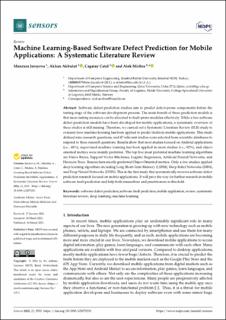| dc.description.abstract | Software defect prediction studies aim to predict defect-prone components before the testing stage of the software development process. The main benefit of these prediction models is that more testing resources can be allocated to fault-prone modules effectively. While a few software defect prediction models have been developed for mobile applications, a systematic overview of these studies is still missing. Therefore, we carried out a Systematic Literature Review (SLR) study to evaluate how machine learning has been applied to predict faults in mobile applications. This study defined nine research questions, and 47 relevant studies were selected from scientific databases to respond to these research questions. Results show that most studies focused on Android applications (i.e., 48%), supervised machine learning has been applied in most studies (i.e., 92%), and object-oriented metrics were mainly preferred. The top five most preferred machine learning algorithms are Naïve Bayes, Support Vector Machines, Logistic Regression, Artificial Neural Networks, and Decision Trees. Researchers mostly preferred Object-Oriented metrics. Only a few studies applied deep learning algorithms including Long Short-Term Memory (LSTM), Deep Belief Networks (DBN), and Deep Neural Networks (DNN). This is the first study that systematically reviews software defect prediction research focused on mobile applications. It will pave the way for further research in mobile software fault prediction and help both researchers and practitioners in this field. Keywords: software defect prediction; software fault prediction; mobile application; review; systematic literature review; deep learning; machine learning | en_US |

